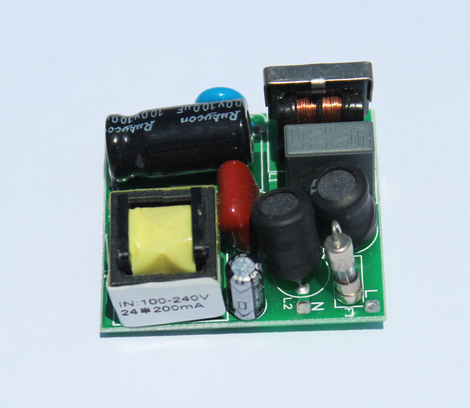Do you know what an LED driver power supply is?
2021-12-16
The LED driver power supply is actually a kind of power supply, which is just a specific power supply, which drives the LED to emit light with voltage or current. Therefore, the input part of the LED driver power supply generally includes several parts: power frequency mains, low voltage DC, high voltage DC, low voltage and high frequency AC, etc.; while the output is mostly constant current that can change the voltage with the change of the LED forward voltage drop. source. The core components of the LED driver power supply include input filter components, switch controllers, inductors, MOS switch tubes, feedback resistors, output filter components, etc. In addition, some drive power supplies have input over-voltage/under-voltage protection, open-circuit protection, over-current protection, etc.

Second, the characteristics of LED driver power
1. High reliability: It is especially like the driving power supply of LED street lights, installed at high altitude, it is inconvenient to maintain, and the maintenance cost is also high;
2. High efficiency: LED is an energy-saving product, and the efficiency of the driving power supply should be high. It is very important for the power supply installed in the luminaire to dissipate heat from the junction. The efficiency of the power supply is high, so its power consumption is also small, the heat generated inside the lamp is small, and the temperature rise of the lamp is also small, which is beneficial to delay the light decay of the LED;
3. High power factor: Power factor is the requirement of the power grid on the load. Generally, there are no hard indicators for electrical appliances below 70W. Although the power factor of a single consumer with low power is lower, it has little effect on the power grid, but the large amount of lighting at night and too concentrated similar loads will cause serious pollution to the power grid. For 30W~40W LED driver power supplies, there may be certain index requirements for power factors in the future;
4. Drive mode: At present, there are generally two drive modes: ①One constant voltage source supplies multiple constant current sources, and each constant current source individually supplies power to each LED. In this way, the combination is flexible, one LED failure will not affect the work of other LEDs, but the cost will be slightly higher; ②Direct constant current power supply, LED series or parallel operation. Its advantage is that the cost is lower, but the flexibility is poor, and it must solve the problem of a certain LED failure without affecting the operation of other LEDs;
5. Surge protection: The ability of LEDs to resist surges is relatively poor, especially the ability to resist reverse voltage. It is also important to strengthen protection in this area. Some LEDs are installed outdoors, such as LED street lights. Due to the initiation of the grid load and the induction of lightning strikes, various surges will invade from the grid system, and some surges will cause damage to the LED. Therefore, the LED driver power supply must have the ability to suppress the intrusion of surges and protect the LED from damage.
6. Protection function: In addition to the conventional protection function of the power supply, it is better to add negative feedback of LED temperature to the constant current output to prevent the LED temperature from being too high;
7. Protection: For lamps installed outdoors or in complex environments, the power supply structure needs to have requirements such as waterproof, moisture-proof and high-temperature resistance;
8. Safety regulations: LED driver power products need to comply with safety regulations and electromagnetic compatibility requirements;
9. Others: For example, the LED driver power supply needs to match the life of the LED.
Three, LED driver power classification
1. According to the driving mode, it is divided into constant current type and constant pressure type
1) Constant current type: The characteristic of constant current type circuit is that the output current is constant, and the output voltage changes with the change of the load resistance. The constant current power supply driving LED is an ideal solution and it is not afraid of load short circuit, and the LED brightness consistency is better. Disadvantages: high cost, completely open the load is forbidden, the number of LEDs should not be too much, because the power supply has the maximum withstand current and voltage.
2) Constant voltage type: The characteristic of the constant voltage drive circuit is that the output voltage is constant, the output current changes with the change of the load resistance, and the voltage will not be very high. Disadvantages: It is forbidden to short-circuit the load completely, and voltage fluctuations will affect the brightness of the LED.
2. According to the circuit structure, it is divided into capacitor step-down, transformer step-down, resistance step-down, RCC step-down, and PWM control type
1) Capacitor step-down: The LED power supply that adopts the capacitor step-down method is easily affected by the fluctuation of the grid voltage, the impulse current is too large, and the power supply efficiency is low, but the structure is simple
2) Transformer step-down: This method has low conversion efficiency, low reliability, and heavy transformer
3) Resistor step-down: This method is similar to the capacitor step-down method, except that the resistor needs to consume more power, so the power supply efficiency is relatively low;
4) RCC step-down type: This method is used a little more, not only because of its wide voltage regulation range, but also its power utilization efficiency can reach more than 70%, but its load voltage ripple is relatively large;
5) PWM control mode: It is necessary to mention the PWM control method, because for now, the LED power supply designed by the PWM control method is ideal. The output voltage or current of this LED driver power supply is very stable, and the power supply is converted. The efficiency can also reach 80%, or even more than 90%. It is worth noting that this power supply can also be equipped with multiple protection circuits.
3. According to whether the input and output are isolated, it can be divided into isolated type and non-isolated type
1) Isolation: Isolation is to isolate the input and output through a transformer for safety. Common topology types include forward, flyback, half-bridge, full-bridge, push-pull, etc. Forward and flyback topologies are mostly used in low-power applications, with few devices but simple and easy to implement. Among them, flyback has a wide input voltage range and is often combined with PFC, and its application is more widely used for flyback isolated drive.
2) Non-isolated: Isolated drivers are generally powered by batteries, accumulators, and stabilized power supplies, and are mainly used for portable electronic products, miner’s lamps, automobiles and other electrical equipment.




